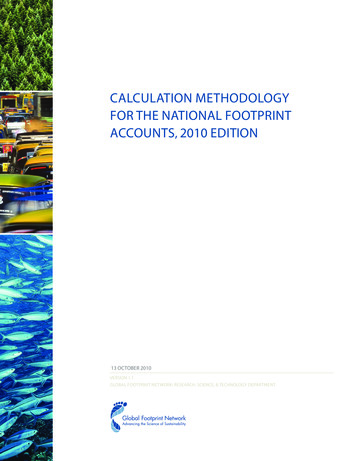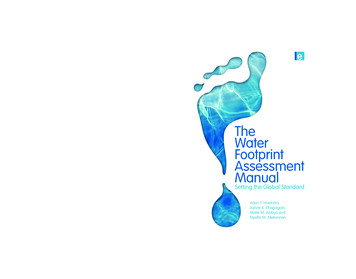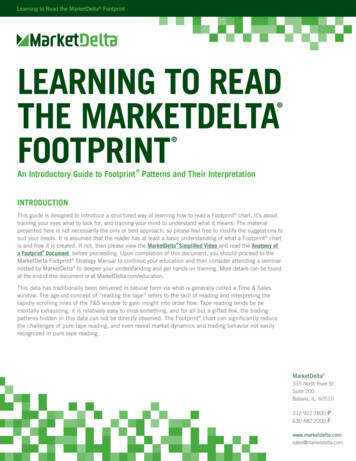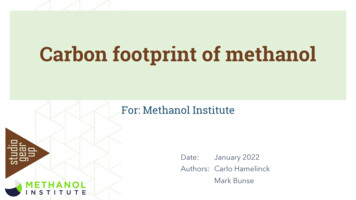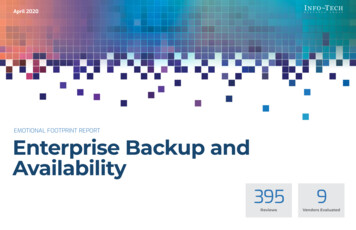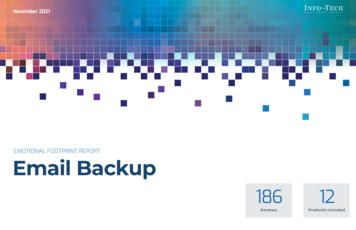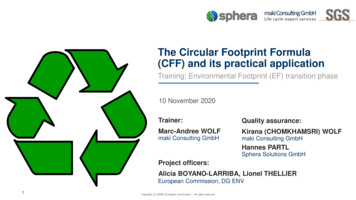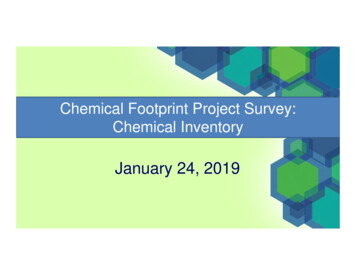
Transcription
Chemical Footprint Project Survey:Chemical InventoryJanuary 24, 20191
PresentersMark S. Rossi, PhDSally Edwards, ScDExecutive DirectorClean Production ActionSenior Research AssociateLowell Center for Sustainable Production2
Zoom Webinar: Q&A and Chat3
Chemical FootprintProject (CFP)ChemicalFootprintingCFP Survey4
Chemical Footprint Project (CFP)Survey Webinar Series January 17: Management StrategyJanuary 24: Chemical InventoryJanuary 31: Footprint MeasurementFebruary 7: Public Disclosure & VerificationAll webinars: 11:00am‐12:30pm EST– Note: calls may not go full 90 minutes dependingon number of questionsWebinars recorded & posted at:www.chemicalfootprint.org2018 Guidance document ds/cfp guidance 2018 20190102.pdf5
Today’s Webinar (1/24)& EDF Webinar (1/30) Today: Chemical Inventory section of Guidance Document– I1: RSL / MRSL– I2: Implementation of I1– I3: Chemical information from suppliers– I4: Full chemical ingredient information– I5: Chemical ingredient data management– I6: Conformance with inventory requirements– Q&A: post your Qs to Zoom Q&A paneEDF webinar on CFP – value proposition from investor &retailer perspective on 1/30 772861612259876
Investors include Bank J Safra Sarasin BNP Paribas Investment Partners Boston Common Asset Management Calvert Research & Management Impax Asset Management Legal & General Investment Management Rhode Island Treasury The Sustainability Group of Loring,Wolcott & Coolidge Trillium Asset ManagementRetail & Health Care includes CVS Health, Staples, Target, & Walmart Dignity Health, Kaiser Permanente, &Vizient7
Value of CFP Common language Gap analysis Quantitative metric to measureprogress Alignment with leadingdemands from businesses,purchasers, & investors Systemic framework thatsupports compliance withstandards & eco‐labels8
March 31, 2019:Survey Closes9
CFP Survey:19 Questions 100 points10
Chemical InventoryCFP Survey: 20 Questions, 100 pts11
Why focus on Chemical Inventory?12
Key Terms:Chemical of High Concern (CoHC) carcinogen, mutagen, or reproductive toxicant (CMR) persistent, bioaccumulative and toxic substance (PBT) any other chemical for which there is scientific evidence of probable seriouseffects to human health or the environment that give rise to an equivalent levelof concern a chemical whose breakdown products result in a CoHC that meets any of theabove criteriaAligns with GHS criteria and GreenScreen Benchmark 1 criteriaCFP CoHC 2018 List: updated and consistent with GreenScreen List Translator 1chemicals l‐guidance‐document13
Key TermsRestricted Substances List (RSL): A list of chemicals restricted by a companyin products, parts, or components from its suppliers.Manufacturing Restricted Substances List (MRSL): A list of chemicals bannedfrom intentional use in facilities that process materials, components and/orproducts.Watch List: A list of chemicals of concern that a company does not currentlyprohibit, but is considering prohibiting in the future due to scientific evidencethat a chemical may cause harm to human health or the environment.14
CFP SurveyCHEMICAL INVENTORY INDICATORS (30 points)Restricted SubstancesI1. What is the scope of chemicals you restrict?I2. How do you ensure requirements are up‐to‐date & implemented effectively?Data collectionI3. What chemical information do you request from suppliers?I4. For what % of products do you collect full chemical ingredient info?Data Management & ConformanceI5. What capabilities do you have for managing data?I6. How does your company ensure conformance with your chemicals requirements?15
Chemical InventoryAbsenceof chemicalsData management/conformancePresenceof chemicals16
I1: What is the scope of chemicals of concern you restrict in yourproducts and manufacturing processes? (5 points)a.b.c.d.e.f.g.uses our RSL(s) to manage legal compliance within each market where it operates. Our RSL(s) include(s)only chemicals that are legally restricted in each market.uses a single RSL that reflects the strictest regulation in all of the countries or markets in which the brandoperates and sells products (e.g., regulations that apply to manufacturing, marketing, and saleslocations).uses a single RSL that reflects the strictest regulation in all locations worldwide.a single RSL that includes limits or bans of chemicals beyond what is covered in the most restrictiveglobal regulations, or it includes chemicals that may not be subject to regulation but which the registranthas voluntarily chosen to limit or ban from its products.developed an MRSL.uses a list of chemicals identified for reduction beyond regulatory requirements. Our company may ormay not require suppliers to eliminate these chemicals in products, parts, or components.uses none of the above.17
I1: What is the scope of chemicals of concern you restrict in yourproducts and manufacturing processes? (5 points)‐ Restricted Substances List legal compliance only strictest standard across jurisdictions where company operates strictest standard worldwide voluntary limits beyond strictest regulations‐ List of chemicals identified for reduction: may or may not berequired‐ Manufacturing RSL – covers process chemistry18
Absence of Chemicals:Scope of Restricted Substances List (RSL)Market‐specific legal restrictionsMost stringent legal restrictionsManufacturing RSL(MRSL)Market12Most stringent restrictionsworldwide3Voluntary restrictions19
Example of I1c: AAFA 2018 RSL20
Example of I1e: ZDHC MRSL21
I2: What actions does your company take to ensure that itsrequirements (as selected in I1) are current and implementedeffectively? (5 points)a.b.c.d.e.f.delineates compliance requirements in contracts with suppliers.trains suppliers about how to comply with our requirements.updates our RSL/MRSL/other requirements at minimum on an annualbasis.engages external stakeholders such as non‐governmental organizations(NGOs), business customers, and consumers in the development of ourRSL/MRSL/other requirements.publicly discloses our RSL/MRSL/other requirements. Provide web link.uses none of the above.22
Example of I2a: HP “Active Verification”23
Example of I2b: AFIRM Group ‐ Training Materials24
Examples of I2e: publicly available RSLs25
I3: What chemical information does your company, either directly orthrough a respected third‐party, collect from suppliers? (5 points)a. confirm RSL complianceb. confirm RSL compliance info on Watch List (1 –50 chemicals)c. confirm RSL compliance info on Watch List ( 50 chemicals)d. request full chemical ingredient information.e. require full chemical ingredient information26
I3: What chemical information does your company, eitherdirectly or through a respected third‐party, collect fromsuppliers? RSL (confirm absence of chemicals of concern) Watch List (partial ingredient information) Full chemical ingredient information: request orrequire27
I4: For what percentage of products sold by yourcompany do you collect full chemical ingredientinformation? (5 points)IntentThis question seeks to understand the scope of yourcompany’s data collection on full chemical ingredientinformation. It is available only if, in question I3, you havechecked response options “d” or “e.”I3.d. request full chemical ingredient information.I3.e. require full chemical ingredient information28
I4: For what percentage of products sold by your company do youcollect full chemical ingredient information?Answer all that apply.14a. Formulated Products: For what percentage of formulated products sold by yourcompany is full chemical ingredient information collected? percent14b. Articles: For what percentage of articles sold by your company is full chemicalingredient information collected? percent29
I4: For what percentage of products sold by your company do you collectfull chemical ingredient information?Key definition: “Full Chemical Ingredient Information”with different requirements for “formulated products” and “articles” Formulated products:o 100% of the intentionally added substances by mass ando any likely impurities that are both a CoHC and present at 100 parts per million (ppm) orhigher in the formulation. Articles at the level of homogeneous material (definition of “article” based on REACH):o 95% of the intentionally added substances by mass ando any likely impurities that are both a CoHC and present at 1000 ppm or higher. For definitions of “formulated products” and “article” see Appendix C: Glossary of Terms30
I4: For what percentage of products sold by your company do youcollect full chemical ingredient information?Key reporting & documentation requirements: Report using either:o mass – percent of full chemical ingredient information collected by mass ofproducts sold; oro sales – percent of full chemical ingredient information collected by number ofunits or dollars of products sold.Other metrics can be used, such as product categories, but these units of analysisare less preferred as they require more details to understand how they are defined. Documentation: must clearly demonstrate how percent of products sold wascalculated and how “full chemical ingredient information” is collected, includingimpurities31
I4: For what percentage of products sold by your company do you collect fullchemical ingredient information?Source: ttp://lup.lub.lu.se/luur/download?func downloadFile&recordOId 8962508&fileOId 896251032
I5: What capabilities does your company have formanaging data on chemical ingredients in its products?(5 points)Check all that apply. Our company has:a. an internal named point(s) of contact or outside contractor who communicateswith suppliers concerning our chemical information requirements.b. a data system (either internal or third party) to manage an inventory ofchemicals in products.c. a data system (either internal or third party) that links our inventory ofchemicals in products to chemical hazard information.d. a data system for generating reports on chemical/material ingredientdeclarations to customers.e. none of the above.33
I5: What capabilities does yourcompany have for managing data onchemical ingredients in its products?b. a data system to manage aninventory of chemicals in productsd. a data system for generating reportson chemical/material ingredientdeclarations to customersSource: http://lup.lub.lu.se/luur/download?func downloadFile&recordOId 8962508&fileOId 896251034
I5: What capabilities does your company have for managing data on chemical ingredientsin its products?c. a data system (either internal or third party) that links our inventory of chemicals inproducts to chemical hazard information.Third party examples include 35
I6:How does your company ensure conformance withyour chemicals requirements? (5 points)Check all that apply. Our company:Formulated Productsa. has an audit program to verify supplier submitted data.b. requires suppliers to test parts in third party approved labs and provideresults.c. trains suppliers on how to comply with reporting requirements.d. routinely tests parts, components, or products to ensure conformance withreporting requirements.e. has none of the above.36
I6b. requires suppliers to test partsfor compliance to REACH, RoHS,halogen‐free, etc.c. trainssuppliers onhow to complywith reportingrequirementsa. has an /ee images/uploads/resources/UNEP BusinessCaseForChemicalsInProducts English final.pdf37
I6:How does your company ensure conformance with your chemicals requirements?c. trains suppliers on how to comply with reporting requirementsd. routinely tests parts, components, or products to ensure conformance with reporting requirements.Source for quotes: http://lup.lub.lu.se/luur/download?func downloadFile&recordOId 8962508&fileOId 896251038
Timeline January 1, 2019January‐February 2019March 31, 2019Q2/Q3 2019Q2/Q3 2019CFP Survey openedCFP webinar seriesSurvey closesCFP Survey scores released to respondersCFP 2019 Annual Report released39
Questions?For follow‐up questions or clarifications contact:Cheri Peele, Senior Research Associatecheri@cleanproduction.orgClean Production ActionFor resources go to: www.chemicalfootprint.org40
Chemical Footprint Project (CFP) Survey Webinar Series January 17: Management Strategy January 24: Chemical Inventory January 31: Footprint Measurement February 7: Public Disclosure & Verification All webinars: 11:00am‐12:30pm EST - Note: calls may not go full 90 minutes depending
